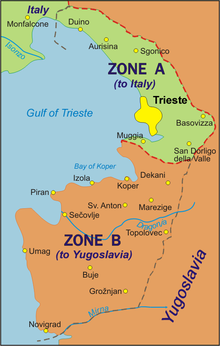Treaty of Osimo

The Treaty of Osimo was signed on 10 November 1975 by the Socialist Federal Republic of Yugoslavia and the Italian Republic in Osimo, Italy, to definitely divide the Free Territory of Trieste between the two states. The treaty was written in French and became effective on 11 October 1977.
The treaty was based on the memorandum of understanding signed in London in 1954, which had handed over the provisional civil administration of Zone A to Italy, and of Zone B to Yugoslavia. The Treaty of Osimo merely made this situation definite. Zone A, including the city of Trieste, became the Italian Province of Trieste, but Yugoslavia was granted free access to the port of Trieste.
The Italian Ministry of Foreign Affairs was never involved in the negotiation, which was carried on almost single-handedly by Eugenio Carbone, then Director General of the Ministry of Industry and Commerce, who also signed the Treaty on behalf of the Italian government. For Yugoslavia the treaty was signed by the Minister of Foreign Affairs Miloš Minić.
Criticism in Italy
The Italian government was criticized harshly for signing the treaty, particularly for the secretive way in which negotiations were carried out, skipping the traditional diplomatic channels. Italian nationalists rejected the idea of giving up Istria, since Istria had been an ancient Italian region together with the Venetian region (Venetia et Histria). The antique Italian eastern border line lies in Istria and is defined as the river Arsia (today Rasa). Furthermore Istria had belonged to Italy for the 25 years between World War I and the end of World War II, and the west coast of Istria had long had a largely Italian population. Some even called for the prosecution of the then Prime Minister and the Minister of Foreign Affairs for the crime of treason, as stated in Article 241 of the Italian Criminal Code, who mandates a life sentence for anybody found guilty of aiding and abetting a foreign power to exert its sovereignty on the national territory. Furthermore, the treaty did not guarantee the protection of the Italian minority in the Yugoslav zone - while it also did not do this for the Slovenian minority in the Italian zone. The question of protection of minorities was to be taken care of later through the signing of separate protocols.
Slovenia's and Croatia's independence
Slovenia declared its independence in 1991 and was recognized internationally in 1992. Though the treaty's applicability was now in question, Slovenia then released a declaration, saying it would recognize the treaty. Solving this question had been made a pre-condition for negotiations on Slovenia's accession to the European Union.
No similar declaration was made by the Croatian government. However, Italy did not insist on a declaration by Croatia, and the treaty was never questioned by Croatia which considers it to be a valid treaty. Also, since Croatia does not border the Italian zone, the acceptance of the treaty by Croatia is not as important.
